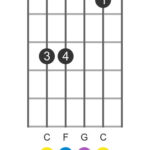For guitar players exploring the vast world of music, techniques that enrich simple melodies are always sought after. When diving into popular songs like “Let It Be” using guitar tabs, you might notice a certain resonance and depth that goes beyond just playing the right notes. This is often due to a musical concept known as lasciare suonare.
Lasciare suonare, an Italian term meaning “let ring,” is a technique where notes are allowed to sustain and decay naturally after being played, without being artificially dampened. This approach creates a rich, reverberant sound, adding complexity and a haunting quality even to simple musical passages. Think about instruments with natural sustain, like plucked strings of a guitar or struck blocks. These instruments inherently lend themselves to this technique.
The beauty of lasciare suonare is evident across various instruments. On a piano, this effect can be achieved by using the sostenuto pedal, allowing selected notes to ring out while others are played normally. Imagine the charming sound of a wind-up music box; its delightful, slightly blurred tones are a direct result of lasciare suonare. The harp, with its ethereal and magical sound, also owes much of its allure to this technique, as notes gently overlap and resonate. Similarly, instruments like the vibraphone, metallophone, and xylophone are often played lasciare suonare to maximize their resonant qualities.
Even without consciously employing lasciare suonare, guitarists often experience its effects. When playing legato or holding notes for their full duration, especially on acoustic guitars, successive notes blend together. This is because the damping of guitar strings isn’t instantaneous. The natural decay of the string creates a continuous soundscape where notes subtly bleed into one another.
This phenomenon is not exclusive to guitars or acoustic instruments. In the realm of synthesizers, programmers understand that a note’s volume over time, known as its amplitude envelope, consists of stages: attack, sustain, decay, and release. Decay refers to the gradual fading of the note while it’s held, and release is the final, often quicker, decay after the note is stopped.
Synthesizers can be programmed to have a release time of zero, causing notes to stop abruptly when a key is released. However, this often sounds unnatural, particularly when emulating instruments like the piano or guitar. This abruptness can expose any imperfections in playing technique, highlighting how much the natural sustain and decay contribute to the richness and smoothness of musical performance.
For guitarists learning “Let It Be” guitar tab or any song with sustained chords and arpeggios, understanding lasciare suonare is key. It’s not just about pressing the correct frets; it’s about allowing the guitar to resonate, letting chords ring out, and embracing the natural blend of sounds. This approach can transform a simple tab into a much more musically expressive and emotionally resonant piece. By understanding and utilizing lasciare suonare, guitar players can unlock a deeper level of musicality in their playing, adding depth and beauty to even the most familiar tunes.

